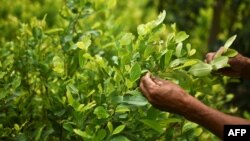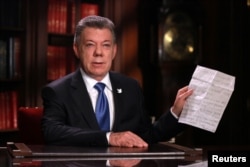Colombia's government and Marxist FARC rebels announced a plan on Friday to substitute illegal crops and eradicate vast tracts of coca leaf, the raw material for cocaine, over the next year as part of a peace deal to end a half-century conflict.
Colombia, which according to the United Nations has more than 96,000 hectares (237,000 acres) sown with coca, manually destroyed 17,642 hectares last year and seized a record 378 tons of cocaine.
Planting of coca was up 39 percent in 2015 after the government halted aerial fumigation with the chemical glyphosate, which was a key part of its U.S.-backed counternarcotics strategy. Colombia and neighboring Peru are the world's leading producers of cocaine.
"The goal is to replace approximately 50,000 hectares of illicit crops during the first year of implementation in more than 40 municipalities in the most affected departments," the government and the rebels said in a joint statement.
The FARC, or Revolutionary Armed Forces of Colombia, was considered one of the biggest players in Colombia's drug business.
President Juan Manuel Santos and FARC leadership agreed on the crop substitution program as part of last year's peace agreement.
Post-Conflict Commissioner Rafael Pardo said the government would invest $340 million in the substitution program, which he said would benefit 50,000 families.
Cacao and fruit trees are among crops that will be planted instead of coca, depending on soil characteristics.
Colombia's conflict, pitting leftist rebels against right-wing paramilitaries and the military, has lasted almost 53 years and taken more 220,000 lives.
The FARC initially "taxed" coca production by farmers in rural areas under its control but it went on to dominate trafficking in those same areas.
The guerrillas vowed to abandon the lucrative drug trade once a peace deal was reached but other armed groups, including paramilitary groups and other crime gangs have been looking to replace the FARC and take over its old income stream wherever possible.











